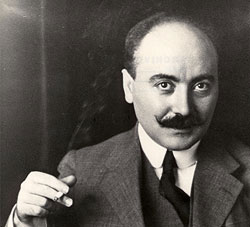Our history
|
The teaching of modern physics in the capital began with the Italian unification. Quintino Sella, who wanted “the new Rome” to play the role of scientific as well as political capital, founded the new university, and in 1872, he called Pietro Blaserna to be chair of Experimental Physics. In 1881 the new Institute of Physics was inaugurated in Panisperna Street. The Institute had been built following the project realised by Blaserna himself, and it is in first place in Italy for the modern conception of spaces for research laboratories and teaching. |
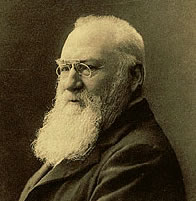 |
|
|
In 1900 Vito Volterra was called to teach Mathematical Physics, and in 1899 the chair of Complementary Physics (which later became Advanced Physics) was established. Alfonso Sella was first called to hold it and then, in 1908, he was replaced by Orso Mario Corbino, who in 1918 succeeded Blaserna in the direction of the Institute. Corbino (appointed Senator of the Italian Kingdom in 1920, and Minister of Education in 1920-1921) played a crucial role in contributing to the development of Physics as a disciplinary sector and in supporting the spread of the "new physics" in Italy. Thanks to him, the first chair of Theoretical Physics in Italy was established. It was won in 1926 by Enrico Fermi, who was then joined in 1930 by Franco Rasetti, holder of the new chair of Spectroscopy. Fermi gathered together the young Edoardo Amaldi, Emilio Segrè, and Ettore Majorana in his group. |
|
The "Via Panisperna boys" led by Fermi, discovered in 1934 the radioactivity induced by neutrons, and in the autumn of the same year the group, which was joined by Bruno Pontecorvo, studied the properties of slow neutrons. In 1936 the Physics Institute (which will be named after "Guglielmo Marconi" from 1937, in honour of the great inventor, scientist, and winner of the Nobel prize in Physics in 1909) moved to the new university campus, in the headquarters of the Department of Physics. In a short time, the original group of Via Panisperna dismembered: Segrè went to hold a chair in Palermo, and Pontecorvo in Paris. At the beginning of 1937 Corbino died, and he was succeeded in the direction of the Institute by Antonino Lo Surdo. At the end of 1938 Fermi was awarded the Nobel prize in Physics; from Stockholm Fermi went directly in the United States and left Italy, and the following year also Rasetti left and went to Canada. |
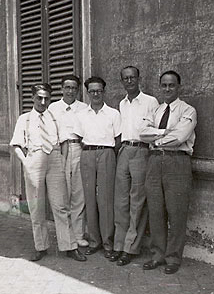 |
|
Of the old group only Amaldi remained in Rome, to keep the guide and coordinate the research at the Physical Institute, along with Bruno Ferretti, Mario Ageno, Gian Carlo Wick, and the young graduates Oreste Piccioni and Marcello Conversi. In 1946, Marcello Conversi, Ettore Pancini and Oreste Piccioni carried on an important experiment in Rome, which is often referred to as the beginning of the research in Elementary Particles Physics: with their experiment they demonstrated that the penetrating particles in cosmic rays (now called "muons") are not the particles hypothesised by Yukawa. In 1945 a "study group for the physics of nuclei and elementary particles" of the CNR was established at the Institute, which was then to be the first nucleus of the National Institute of Nuclear Physics (INFN), founded in 1951. The first president of the INFN was Gilberto Bernardini, professor in Rome from 1946 to 1964, who was then succeeded by Amaldi from 1960 to 1965. Amaldi was also, in the early post-war years, one of the main protagonists of the birth of the CERN in Geneva, of which he was Secretary from 1952 to 1954. In 1959, in the new National Frascati Laboratories of the INFN, the 1100 MeV electrosynchrotron was completed, under the direction of Giorgio Salvini, who passed from the Physics Institute of Pisa to Rome in 1955. |
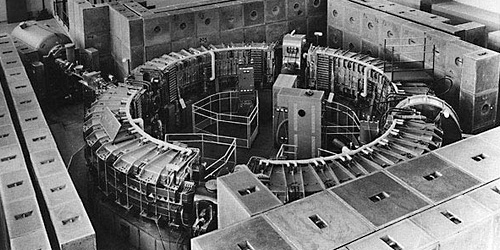   |
The theoretical work for its project was directed by Enrico Persico, one of Fermi's schoolmates, who held the chair of Advanced Physics in Rome from 1949. In 1960, in Frascati, AdA was built, the first colliding beam storage ring for electrons and positrons. It was designed by Bruno Touschek, professor at the Institute of Physics and it represented a model for all the great colliders later built in the world. In 1962 Amaldi promoted the creation of the European Space Research Organization (ESRO), from which the ESA (European Space Agency) was then born. |
|
In the following years the Roman research in the field of Elementary Particles Physics continued to produce excellent results, both in the theoretical field (just remember the contributions of Nicola Cabibbo and Luciano Maiani) and in the experimental field, with the participation of groups of Roman researchers in the fundamental activities of the CERN. But the research activity was not only confined to the field of Elementary Particle Physics and it was developing and differentiating and extending also to other important fields. Under the initial stimulus of professors such as Giorgio Careri and Franco Bassani, the entire field of Solid State Physics and, more generally, of Matter Physics developed much, both in terms of experimental research and in the more theoretical fields of statistical mechanics, with excellent results that led, among other things, to the three Boltzmann medals awarded to professors of our Institute (Giorgio Parisi in 1992, Giovanni Gallavotti in 2007, and Gianni Jona-Lasinio in 2013). |
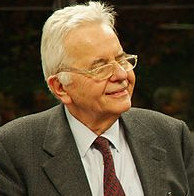 |
|
The Physics Department has been hosting an intense research activity in the major areas of Modern Physics, both as for fundamental and applied research: Particle Physics, Matter Physics, Astrophysics and Cosmology, Theoretical Physics, Mathematical Physics and Statistics, Photonics and Quantum Information, Biophysics, Medical Physics, Atmospheric Physics, Physics and Cultural Heritage and so on, with a number of research fields bigger than one hundred. The Department hosts numerous laboratories with different competences, among which we remember those in Particle Physics, Astrophysics, Computational Physics, Matter Physics, Photonics, Classical and Quantum Physics. In recent years, the Department has been a protagonist in some of the most important scientific results lately achieved in different fields. Among others, we remember the BOOMERanG experiment, which allowed the measurement of the cosmic background radiation of a portion of space, the realization of quantum teleportation, the discovery of the Higgs boson by the ATLAS and CMS experiments and the detection of gravitational waves by the LIGO and Virgo experiments. |

